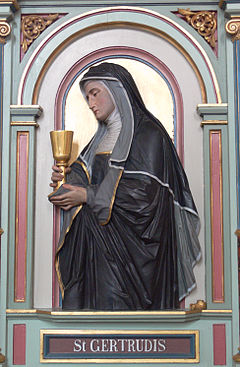Saint Margaret of Scotland (+1093) was the devoted wife of Malcom III, King of the nation to which she fled as a fetching young royal English lass. Her family had been exiled from England, and Margaret was born and raised in a very pious Catholic environment in Hungary, of all places, a nation now returning to its Christian roots after decades of stagnant, atheistic Communism.
The family was recalled to England in 1057, with Margaret’s father, fittingly called Edward the Exile, was considered a possible successor to the childless Edward the Confessor. However, the Edward died mysteriously, and Harold Godwinson was chosen instead, not long after which the new king perished by an arrow through the eye in the maelstrom of the Battle of Hastings (1066 and all that). Margaret’s brother Edgar the Aethling was briefly proclaimed king, but soon deposed by the conquering William – whom Belloc describes by his nickname ‘Mamzer’, or ‘the Bastard’.
Margaret’s widowed mother Agatha intended to take the family back to the continent, but a storm providentially blew their ship off course, and they landed on the shores of the Firth of Forth in bonnie Scotland, being met, as a romantic tradition has it, by King Malcolm himself, a rough, unlettered widower with two sons, who was right away smitten by young Margaret, and, as an added bonus, thought an alliance between the two British kingdoms a fine idea.
Which motivation was foremost, and however they met, they had by all accounts a happy and fruitful union, producing six sons and two daughters: Amongst the lads we find four kings -one of them, David, himself a canonized saint – and one abbot; and the lasses themselves went on to make happy, royal marriages. Even if paterfamilias Malcolm seems to have had little tendency to the formal practice of religion, he rejoiced in the piety of his wife and children, and supported her good works generously, feeding the poor – whose feet she would wash daily – and almsgiving. The good queen set up a ferry system to transport pilgrims across the Firth to the shrine and cathedral at Saint Andrew’s. The landing spot is still called Queensferry in her memory.
When Malcolm and one of their sons died in the Battle of Alnwick against the English on November 13, 1093, it was said that Margaret, hearing the sad news, took to her bed with a broken heart, dying a few days later. She was canonized in 1250 by Pope Innocent IV, and is now one of the patron saints of her adopted nation. Sadly, her remains were dispersed in the insane iconoclasm of the Scottish ‘reformation’ under the fiery apostate priest John Knox, with the famed cathedral of Saint Andrew’s left to fall into rack and ruin.
Margaret’s head was preserved, given centuries later to Mary Queen of Scots as a relic to help in her childbirth – yes, we are rather incarnational, we Catholics. The precious relic then made its way to the exiled Jesuits at Douay after poor Queen Mary lost her own head under the Tudor Elizabeth, before disappearing, as did so much else, in the chaos of the French Revolution. They say that what few relics were left of Margaret and Malcolm were brought by King Philip to the Escorial in Spain, but they have yet to be found. Their memory, however, lives forever, in the hearts of the Scots and people throughout the world.

We also celebrate a consecrated virgin on this day, Gertrude of Helfta, (+1302) or just the ‘Great’, an appellation given her by Pope Benedict XIV to distinguish her from a number of other saintly Gertrudes.
Gertrude was offered to the Benedictines as an oblate as a child – just as her near contemporary Thomas Aquinas was – and brought up, as she wrote in her numerous letters to Christ her Saviour: “Yet you had chosen me to be specially trained to serve you. I was a child of five when I began to live in a convent surrounded by your most devoted friends”.
From early on – and contrary to those who claimed that false canard that the Church limited the learning of women – Gertrude absorbed learning like a sponge, becoming fluent in Latin, and poring over the Fathers and doctors of the Church, from Augustine to Bernard of Clairvaux. It was at the Cistercian convent of St. Mary at Helfta that Gertrude spent the entirety of her relatively short life, going peacefully to her Saviour – to whom she considered herself ‘married’ in a spiritual way – at around the age of 45.
Besides her saintly example, Gertrude is known for her mystical writings which have so influenced the Church’s own theology, as well as future saints and writers, from Philip Neri, Francis de Sales and Teresa of Avila, to Dom Gueranger, whose monks at Solesmes did much to compile her writings; it was Gertrude who was one of the first to spread devotion to the Sacred Heart and the humanity of Christ, as well as prayers for the holy souls in Purgatory, fitting in this month of November.
Two saints examples of two very different walks of life, both of whom did so much to lead so many to heaven.
Orate pro nobis.











